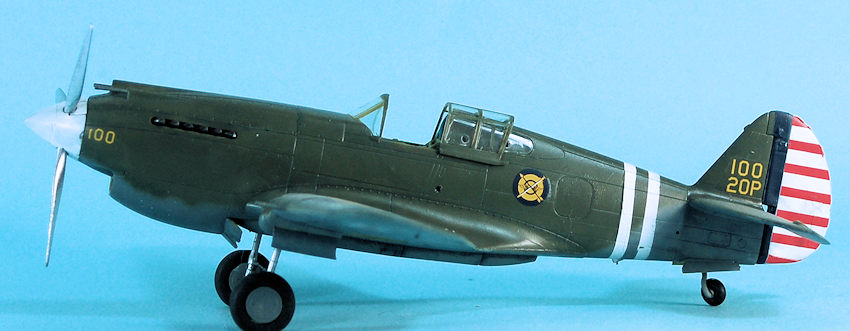
Airfix 1/48 P-40B/C
| KIT #: | A05130 |
| PRICE: | $31.95 |
| DECALS: | Two options |
| REVIEWER: | Tom Cleaver |
| NOTES: | Xtradecal 48162 |

| HISTORY |
With war clouds on the sky in 1938, the Army Air Corps determined it needed a fighter with better performance than the P-36. Curtiss had developed a design strategy stretching back to the P-1 if stretching an airframe as far as possible, and their proposal to essentially re-engine the P-36 with an Allison inline engine was quickly accepted.
The XP-40,
which was the tenth P-36 airframe, first flew on 14 October 1938. The glycol
radiator was positioned under the fuselage aft of the wing. Speed in this
configuration was a disappointing 315 mph, not a significant improvement on the
P-36. Curtiss engineers went to work and developed a more streamlined radiator
positioned under the Allision V-1710 engine. One the basis of the expected
improve ments, 524 P-40s were ordered in April 1939, the largest production
contract for a USAAC fighter to that time. Further tests in December 1939 showed
a top speed of 366 mph.
ments, 524 P-40s were ordered in April 1939, the largest production
contract for a USAAC fighter to that time. Further tests in December 1939 showed
a top speed of 366 mph.
As originally conceived the P-40 was a pursuit aircraft and while it was very agile at low and medium altitudes, it suffered due to lack of power at higher altitudes since it had only a signle-stage supercharger. At medium and high speeds it was one of the tightest-turning early monoplane designs of the war, and could hold its own with European designs it met in combat in North Africa and on the Russian front.
The first production P-40s appeared in the summer of 1940. The armament of two .50 caliber weapons was deemed inadequate, and the P-40B that appeared that fall carried two .30 caliber machine guns in each wing. The original models were later upgraded during the war with a single .30 caliber weapon in each wing as the P-40G. By early 1941, the P-40C appeared, plumbed to carry a 50-gallon drop tank under the fuselage.
The 20th Pursuit Group, based at Hamilton Field north of San Francisco, was one of the first units to equip with the P-40. The unit was originally equipped with the initial P-40, which was supplemented by both P-40B and P-40C aircraft. These were operated until June 1941, when the 20th PG became the only unit to fly the P-40D, the first of the upgraded P-40s with improved fineness ratio in the fuselage and an armament increate to four .50 caliber guns in the wings.
The
Lend-Lease Act was passed in April 1941. Initially, the Army and Navy resisted
this, because they saw it as reducing the new equipment they needed. In May
1941, President Roosevelt signed a secret Executive Order, directing the Army
and Navy to turn over any existing equipment when a unit u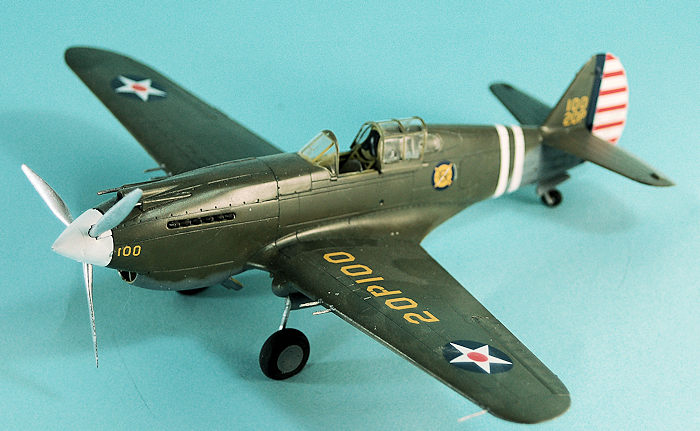 pgraded, to be sent to
Britain under Lend-Lease.
pgraded, to be sent to
Britain under Lend-Lease.
When the 20th Pursuit Group re-equipped with the P-40D in June, the unit turned in their P-40 Bs and Cs to the Curtiss plant in Buffalo. Since these aircraft were the same as the H-87 Tomahawk II the RAF had ordered earlier, Curtiss disassembled the 48 fighters and crated them for shipment on to England as part of the Tomahawk order, thus allowing Curtiss to sell the airplanes twice - once to the USAAC and once to Lend-Lease.
Germany invaded the USSR on 22 June 1941. Winston Churchill immediately offered an alliance to Stalin, and to show good faith the RAF was directed to ship 100 Tomahawk II fighters to Murmansk as soon as possible. Among the 100 Tomahawks were the 48 fighters from the 20th Pursuit Group.
P-30C 41-13390 was one of the aircraft shipped to the USSR. It had previously been flown by the 77th Pursuit Squadron, and arrived in Murmansk still in its pre-war paint and markings. It was overpainted green with red stars and served in the air defense of Murmansk until April 1943, when it suffered engine failure in flight and crashed in a forest. Fifty years later in 1993, the airplane was re-discovered and recovered for The Fighter Collection at Duxford. It was sent to Fighter Rebuilders at Chino for restoration, arriving in 1994. Shortly after arrival, paint stripping began, and the USAAC markings were soon discovered under the Russian paint. As one of the resident historians at Planes of Fame, I identified the markings. Unfortunately, that was one of the few times I did not have my camera with me, and by the time I returned a week later hoping to document the discovery, the industrious guys at Fighter Rebuilders had stripped the airframe to bare metal.
41-13390 now resides at the Flying Heritage Collection, replendent in the camouflage and markings of the 1st Squadron of the AVG.
| THE KIT |
Modelers have longed for a fully-accurate early P-40 since Monogram released theirs 52 years ago in 1964. The first of Monogram’s “serious” kits (it had no toy-like moving parts), Monogram came very close in terms of shape, and the kit is the only one ever released that accurately portrays the fact the P-40 only had flush rivets on the wing leading edge back to the main spar. The molds have long been shot, and without a Squadron/Falcon vac canopy and either a scratchbyuilt cockpit or a resin replacement, the kit has long been due for replacement.
Twenty years
ago Hobbycraft took a shot, but missed the target when they used the wing of
their P-36 kit, which had a very different lower center section than the P-40;
modelers have managed to modify the kit into something more accurate, but it
takes a degree of skill many lack. After botching the P-40B in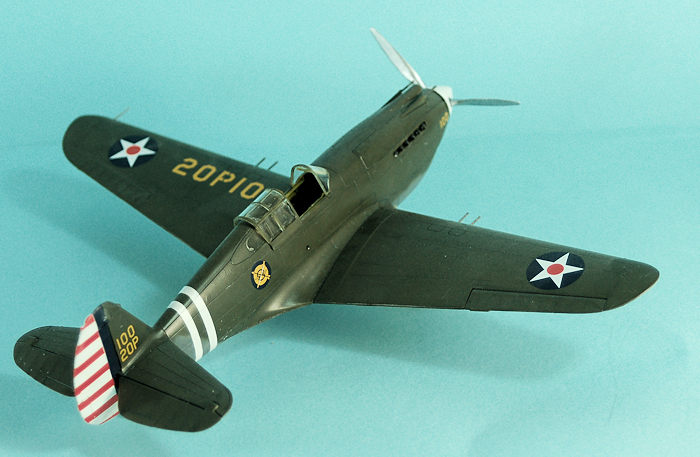 1/32, Trumpeter
compounded their mistakes in 1/48 back in 2005. Hobby Boss multiplied the same
errors in their kit released earlier this year.
1/32, Trumpeter
compounded their mistakes in 1/48 back in 2005. Hobby Boss multiplied the same
errors in their kit released earlier this year.
Thus, when Airfix announced a P-40B/C in 2015, and stated it would be based on research involving an actual P-40C (the airplane restored by Matt Nightingale for The Fighter Collection in 2014), there was a degree of hope expressed. This was soon followed by the Great Red Line Game at a certain modeling discussion board that will remain mercifully unnamed. Hume Bates, who really does know the early P-40 better than anyone, demonstrated some mistakes the CAD drawings had, and it appears Airfix was listening since most of those he listed and described were corrected before molds were cut.
The kit is well-engineered, with panel lines that are not as deep as other Airfix kits and they really do “look OK under a coat of paint.” The cockpit is fully detailed, and there is provision for both the “round back” seat used on the P-40B/C and the “square back” seat used on the RAF Tomahawks. The kit includes a drop tank appropriate for the P-40C. Two different canopies are provided, as was done with the Hurricane kit, to allow it to be posed open or closed. Decals include a P-40C of the 15th Pursuit Squadron at Pearl Harbor and one of the Tomahawk Iis flown by R.T. Smith of the AVG.
| CONSTRUCTION |
The kit is easy to build if you follow the instructions. I did discover a couple of things that make assembly more precise. If you take your time and test fit before gluing, you can easily assemble this model without any putty or filler needed.
I suggest you lightly scrape down the edges of the internal parts, because overall fit is very tight, and any little “edge” of flash will mess things up.
The one
place that is more fiddly than elsewhere is gluing the lower front of the
cowling in position to the radiator intake part. Airfix has you wait to do this
until the fuselage halves are glued together. I found that if you glue that part
to the intake part, and then glue that assembly into a fuselage half, and take
the time to carefully align everything together, you will than have it perfectly
aligned when you glue the other fuselage half to the sub-assembly. I also
suggest that you assemble the upper cowling par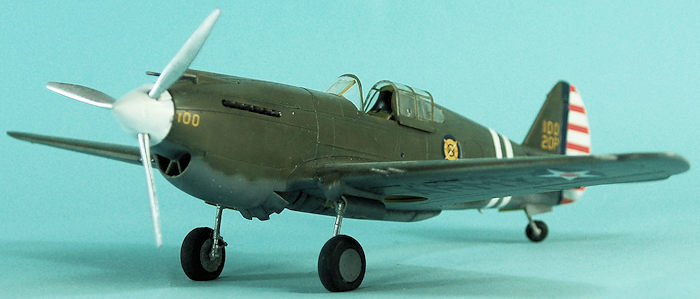 ts to each respective fuselage
half before assembly (rather than after as Airfix suggests) because you can work
the fit from both inside and outside, and get the alignment perfect.
ts to each respective fuselage
half before assembly (rather than after as Airfix suggests) because you can work
the fit from both inside and outside, and get the alignment perfect.
When the wing parts are assembled, there is a noticeable gap along the trailing edge where the flap is. This is not Airfix screwing up the fit, but rather getting it very right. There is in fact a noticeable gap there when the aileron is raised on the real airplane.
Before gluing the wing parts together, I suggest you also scrape down the inner joint of the upper wing along its edges, to insure a good fit since again everything has close tolerances when you assemble the model. Be sure you have trimmed down all sprue nubs everywhere when you cut a part off the tree. Some of the sprue gates are a little thick and you need to be sure of this to insure the nice putty-free fit you want.
A note about the cockpit color: The early P-40 cockpit is painted “tinted green,” which is Yellow Zinc Chromate mixed with Black. It is NOT “Interior Green,” but rather a more yellowish hue. I found that using Tamiya XF-4 “Yellow Green” mixed with Tamiya NATO Black got the color I wanted. The interior of the wheel wells and gear doors, including the canvas “boots” in the main wells and the tail wheel, were painted Yellow Zinc Chromate at the factory. The main well boots were usually removed since it was easier to clean out the interior of the wing than to maintain the boots with the crud they picked up; if they survived long enough for the airplane to be repainted (as with RAF Tomahawks in North Africa that got their desert camo at the Aboukir maintenance facility), they would have been painted the wing underside color. The boots as they are molded by Airfix look very accurate from having seen the original on the restored P-40C when it was at Chino.
Also, all USAAC P-40s had the pre-war US wide lap belt only. No shoulder harnesses. Tamiya 1/8" tape works great for these.
| COLORS & MARKINGS |
I
painted the model as a P-40B used by the 55th
Pursuit Squadron of the 20th
Pursuit Group in 1940-41. I painted the fuselage stripes and masked them off,
and painted the rudder white since the decal sheet only provides the red and
blue parts of the pre-war insignia. I used Tamiya RAF Dark Green for the
g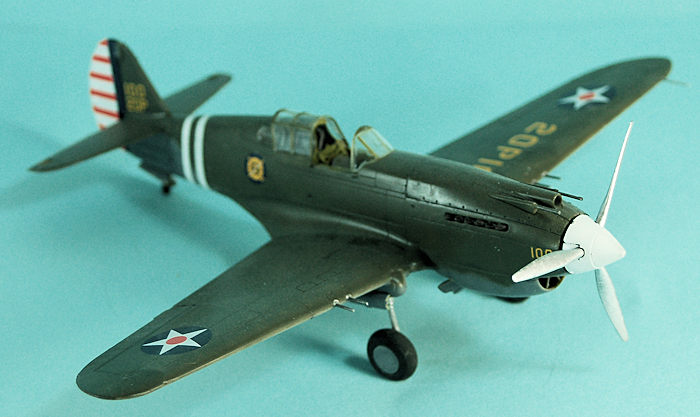 reen-base pre-war olive Drab 41, since that color and the RAF color were
identical, both being based on the official specification for World War II “P.C.
10". The undersides were painted with Tamiya Neutral Grey. I painted the prop
with Vallejo “Aluminum.”
reen-base pre-war olive Drab 41, since that color and the RAF color were
identical, both being based on the official specification for World War II “P.C.
10". The undersides were painted with Tamiya Neutral Grey. I painted the prop
with Vallejo “Aluminum.”
Xtradecal has released two early P-40 sheets that include AVG airplane, several RAF Tomahawks in various camouflage and markings, USAAC airplanes and Russian, as well as Brazilian and Turkish. These are excellent decals. I used them to do my 55th Pursuit Squadron P-40B without problems.
I attached the landing gear and unmasked the canopy. The scallops were attached with Micro Crystal Clear.
| CONCLUSIONS |
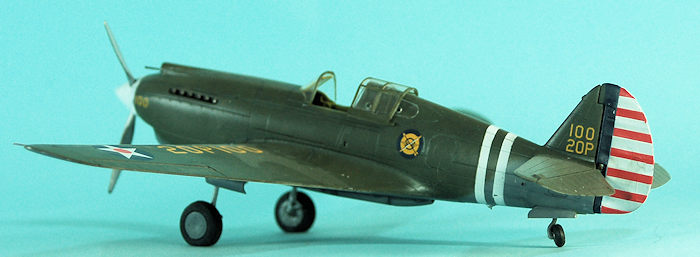 Airfix has a real winner here. The kit is as accurate as we
are likely to see from anyone, and head and shoulders above all other 1/48 early
P-40s. One can do any version of early P-40 with the kit. Assembly is as easy as
the Hurricane kit; any modeler of any ability can get a nice model from this kit
by following the instructions. The kit is highly recommended and I suggest you
buy as many as you can when you can, because this is going to sell out fast.
It’ll likely be another year before Airfix brings out a second pressing (from
what they did with the Spitfire I and the Hurricane I). Highly recommended. Our
50 year wait is over.
Airfix has a real winner here. The kit is as accurate as we
are likely to see from anyone, and head and shoulders above all other 1/48 early
P-40s. One can do any version of early P-40 with the kit. Assembly is as easy as
the Hurricane kit; any modeler of any ability can get a nice model from this kit
by following the instructions. The kit is highly recommended and I suggest you
buy as many as you can when you can, because this is going to sell out fast.
It’ll likely be another year before Airfix brings out a second pressing (from
what they did with the Spitfire I and the Hurricane I). Highly recommended. Our
50 year wait is over.
2 February 2017
Copyright ModelingMadness.com
Thanks to Hornby USA for the review kit.
If you would like your product reviewed fairly and fairly quickly, please contact the editor or see other details in the Note to Contributors.
Back to the Main Page Back to the Review Index Page Back to the Previews Index Page